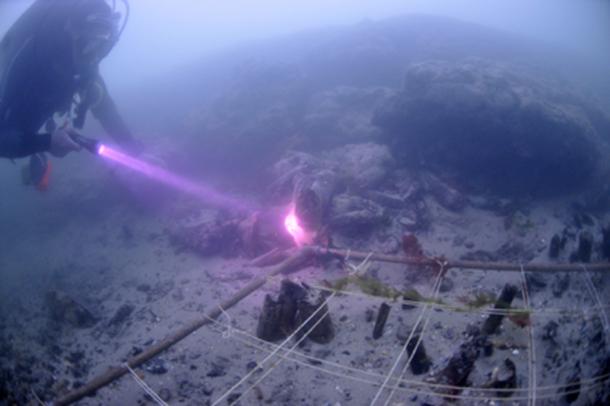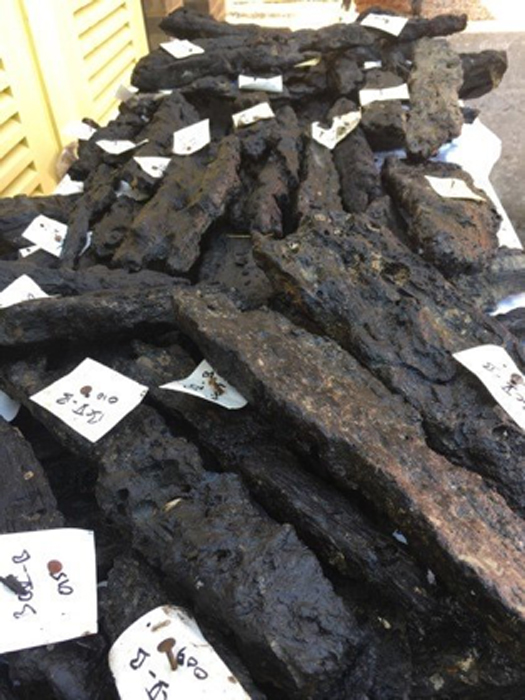
8000-Year-Old Shipyard Located off English Coast is World’s Oldest
Marine archaeologists have published stunning images of what they think is an 8000-year-old shipyard located just off the coast of England. They have just found a large number of timber boards that may have once been a platform on the seafloor. Researchers believe that the submerged structure may provide new insights into Stone Age technology and society.
The find was made by divers from the Maritime Archaeology Trust. They made the discovery at the “submerged Mesolithic landscape at Bouldnor Cliff, [which] lies on the edge of the drowned palaeo-valley and is now 11m underwater” according to the Maritime Archaeology Trust. This location is now located half a mile (1km) east of Yarmouth on the Isle of Wight.


Digital scan of the underwater oldest shipyard site at Bouldnor. Source: Maritime Archaeology Trust
Important underwater archaeological site
Bouldnor Cliff, is in the Solent Maritime Special Area of Conservation and the zone already has five important archaeological sites. It was once dry land which was densely forested and part of a landmass that connected modern England to the continent. It now lies beneath the body of water known as the Solent, that separates the Isle of Wight from England.
Divers have been exploring this area since the 1980s when a drowned Stone Age forest was uncovered. In the 1990s, many worked flints were found, there. In 2005, a great number of worked timber boards were found jutting out of the water. The Conservation zone is located some 36 feet or 11 m below the surface. The Bouldnor Cliff has already yielded many unexpected finds including the earliest piece of string and tools.

Earlier finds of flint and worked wood at the Solent Maritime Special Area of Conservation. (Maritime Archaeology Trust)
World’s oldest shipyard
Two of the locations in the Conservation Zone are of particular importance. One has revealed thousands of flints and stone-age tools. The other is “probably the oldest boat building site in the world” according to the Maritime Archaeology Trust. A DNA analysis of material from the submerged sites demonstrate that wheat was grown in Britain 2,000 earlier than first thought.
The prehistoric site is being constantly eroded by tides. This means that new discoveries are being revealed all the time, but it makes it very challenging for marine archaeologists. During the 2019 season, divers found “a new feature, constructed of over 60 pieces of split and trimmed timbers” reports Maritime Archaeology Trust.

Lower elements of the platform feature reconstructed in the laboratory at the MAT base at the National Oceanography Centre. (Maritime Archaeology Trust)
According to the Maritime Archaeology Trust, Facebook page, “A photomosaic, pre-disturbance survey, of the site was taken at the outset before the different elements of the structure were tagged”. Some planks were removed, and white cord was used to mark the blackened timbers on the peat on the seabed. This allowed the marine archaeologists to develop a model of how the structure looked like in the ancient past and enabled divers to further excavate the site.
- Two Roman Ships that Were Lost in WWII: What Destroyed the Floating Palaces of Emperor Caligula?
- The Ghost Ships of San Francisco: Dozens of Wrecks Buried Beneath City Streets
- Remnants of 18th Century Ship May Provide Clues to Revolutionary-era Shipbuilding
Mysterious wooden structure
The boards had been carefully arranged and covered an area approximately 3 feet (1m) by 6 feet (2m). Some other constructions were also located on the sea bed and they all appear to be interlinked. The Maritime Archaeology Trust websites state’s that “Three layers of flattened worked pieces were placed on top of horizontal round-wood that ran underneath and perpendicular to the main structure”.
According to the Daily Mail the structure of boards “could be platforms, walkways or collapsed structure”. Most likely it was a platform. During the Stone Age, it could have been a free-standing platform in a wetland, which long ago sank to the bottom of the sea. The structure found is “the most intact, wooden Middle Stone Age structure ever found in the UK” reports the Daily Mail.
The connection of the structure to the world’s oldest shipyard is unknown, but both are adjacent to each other. It is entirely possible that the wooden platform was part of the shipyard complex. The discovery has provided researchers with a great deal of worked wood for study. The Trust’s director Garry Momber, told the BBC that the discovery “doubles the amount of worked wood found in the UK from a period that lasted 5,500 years”.

A diver examines the site (NOC)
The timber has been removed to the National Oceanography Centre (NOC) in nearby Southampton. Here specialists will record and examine the wood. They will also chemically treat it and attempt to partially reconstruct the original sunken structure.
New insights into the Stone Age
The latest discovery under the waters of the Solent is a further indication of a sophisticated Mesolithic society, that once thrived in this area. It is demonstrating that the people in this era were much more technologically advanced than previously thought. It appears that they had certain capabilities up to 2000 years earlier than once believed. This is dramatically changing our understanding of the Stone Age.
Mr Momber explained according to the NOC report, “The site contains a wealth of evidence for technological skills that were not thought to have been developed for a further couple of thousand years, such as advanced wood working.”

All elements and layers of the platform feature reconstructed at the MAT base at the National Oceanography Centre. (Maritime Archaeology Trust)
Marine archaeologists are trying to record as much of the sunken platform as possible because it is being quickly eroded by the tides in the Solent. The structure is underwater and therefore does not receive any legal protection. The Trust, which has charitable status, is striving to protect the sunken platform for posterity with the help of its supports and donors. It is hoped that some of the wood may eventually go on public display.
Find out how you can support the work here.
Top image: Wooden canoes. Credit: hanohiki / Adobe Stock
By Ed Whelan















